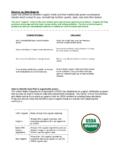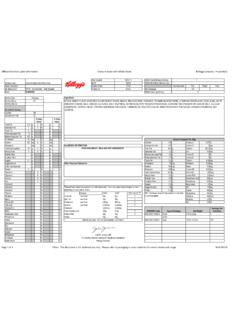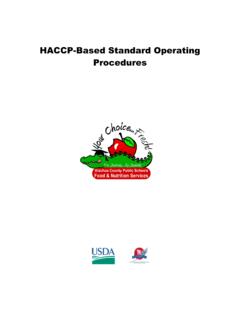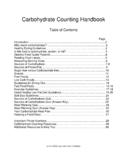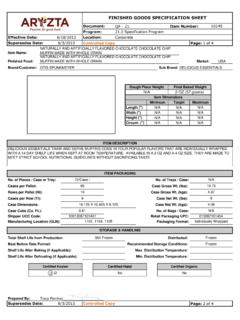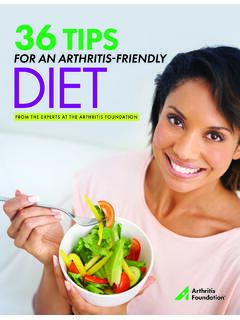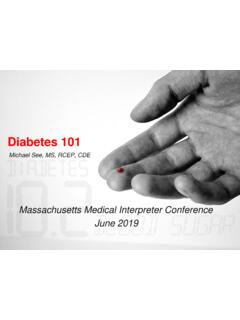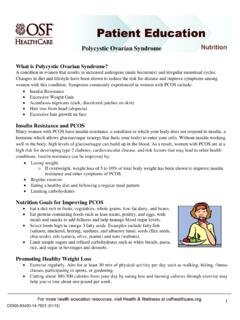Transcription of Carbohydrate Counting Handbook
1 Carbohydrate Counting Handbook Table of Contents Page Why count carbohydrates? .. 2 Healthy Eating Guidelines ..2 Is this food a Carbohydrate , protein, or fat? ..3 Diabetic Food Guide Reading Food Measuring Serving 6 Sources of Sources of sugar -free versus Free Low Carb Guidelines for Dining 14 Fast Food 15-16 Exercise 17-18 Heart Healthy Low-Fat Diet 19-20 Sick Day 21 Sources of Carbohydrate 22 Sources of Carbohydrate Quiz (Answer Key)..23 Meal Planning 24 Meal Planning Quiz (Answer Key).. 25 Your Carbohydrate Meal 26 Keeping a Food 27 Important Phone 28 Carbohydrate Counting Additional Resources to Help You.
2 30 2 Introduction The eating regimen for someone with diabetes is a healthy way of eating from which the entire family can benefit. This Handbook will provide you with the basic survival skills to count carbohydrates while eating a healthy diet. Why Count Carbohydrates??? Food is made up of many different nutrients: Carbohydrate Protein Fat Vitamins and minerals Water Fiber Our bodies need a little bit of each of these nutrients. But, when someone has diabetes they need to pay close attention to the amount of Carbohydrate that they consume. Carbohydrate is the nutrient that breaks down to sugar in our bodies as we digest it.
3 Our bodies use Carbohydrate for energy. In order to utilize that energy, however, insulin must be available to carry sugar (glucose) into cells. Because people with diabetes have impaired insulin production and/or utilization, sugar can build up in their blood , causing hyperglycemia, if they take in too much Carbohydrate at one time. This is why it is very important to count the grams of Carbohydrate in the foods that you eat. It will allow you to control your diabetes better by eating the correct amount of carbohydrates for the amount of insulin that your doctor prescribes. Carbohydrates and insulin are a balancing act. Healthy Eating Guidelines Guidelines for meal planning: Eat a variety of foods to make sure your diet is well balanced.
4 Limit intake of sweets, fats, and salt to make your diet healthier. Increase intake of fiber. Eat meals and snacks at the same time each day. Eat the same amount of carbohydrates at meals and snacks . 3Is this food a Carbohydrate , protein, or fat? Now that you will be Counting carbohydrates, you will need to determine if the food that you are eating contains carbohydrates. If any food contains more than 5 grams of Carbohydrate per serving you will need to include it in your meal plan. Foods can be a combination of Carbohydrate , protein, and/or fat . You can use the food guide pyramid to help you determine if a food is a Carbohydrate , protein, or fat, or a combination.
5 Carbohydrate Group: Grains, dried beans, starchy vegetables Fruit Milk & yogurt Protein Group: Beef, pork, poultry, fish Eggs, cheese Nuts Tofu Fat Group: Butter Margarine Oils Lard Sour cream Mayonnaise Salad dressings* (see page 9 ) 4 Diabetic Food Guide Pyramid 5 Reading Food Labels There are two steps to follow when reading food labels to count carbohydrates: 1. Look at the serving size for the food. This is located at the top of the label. 2. Look at the total Carbohydrate amount. This is located towards the middle of the label.
6 These two parts of the label tell you what you need to know. The amount of total carbohydrates listed is for the particular serving size listed. Also keep the following information in mind when reading food labels: Sugars reflect both added sugars and those that naturally occur in foods. It is important to look at the total amount of Carbohydrate rather than the source. If sugar alcohols are listed on the food label, divide that number by 2 and subtract it from the total Carbohydrate . ( sugar alcohols only provide half the calories as sugar .) If dietary fiber is listed on the food label, you can subtract the full amount of fiber from the total Carbohydrate . (Fiber is not digested as sugar and therefore, will not have an effect on our blood sugar .)
7 6 Measuring Serving Sizes Measuring the serving size of the items that you are choosing to eat is very important. The total amount of carbohydrates depends on the serving size. Therefore, it is very important that you have measuring cups, spoons, and/or a food scale. The following is a list of descriptions to help you visualize what a serving size might look like, in case measuring cups are not available. Easy Ways to Estimate Portion Size 3 oz boneless meat = deck of cards 1 oz slice cheese = 3 computer disk Medium piece of fruit = baseball or tennis ball 2 Tbsp peanut butter = golf ball cup dried fruit = golf ball 1 pancake = compact disk (CD) 1 serving of chips (1 oz) = 1 small cupped hand 7 Sources of Carbohydrate Each item listed with its accompanying serving size contains about 15 grams of Carbohydrate or 1 serving(exchange) of Carbohydrate .
8 Breads 1 slice bread 2 slices reduced-calorie bread 1 1oz. dinner roll hamburger/hot dog bun bagel English muffin 1 2 -inch biscuit 1 2-inch cube cornbread 6-inch pita 1 6-inch tortilla 2 6-inch taco shells 1 4 -inch waffle 2 4-inch pancakes 1 slice French toast 1 cup croutons 1/3 cup stuffing, bread (prepared) Cereals and Grains cereal bar unfrosted poptart or toaster pastry cup bran cereal cup unsweetened cereal cup sugar -frosted cereal 1 cup puffed cereal cup Shredded Wheat cup Grape-Nuts cup oats cup cooked cereal (grits, oatmeal) 1/3 cup couscous 3 Tbsp flour (dry) 3 Tbsp cornmeal (dry) 3 Tbsp wheat germ cup pasta (cooked) 1/3 cup rice (white or brown) (cooked)
9 Cup rice milk Starchy Vegetables cup corn 1 corn on cob, 6-inch cup peas 1 3oz potato, plain (baked or boiled) cup mashed potatoes cup yam, sweet potato, plain 1 cup squash, winter (acorn, butternut) 1/3 1/2 cup tomato or spaghetti sauce 1 cup vegetable juice Beans, Peas, and Lentils 1/3 cup baked beans cup beans/peas, cooked (garbanzo, pinto, kidney, white, split, black-eyed) 2/3 cup lima beans cup lentils, cooked Crackers and snacks 7 saltine crackers 15-20 tortilla or potato chips 24 oyster crackers 8 animal crackers 3 2- -inch square graham crackers oz pretzels - soft pretzel 3 cups popped popcorn 2 4-inch rice cakes cup chow mein noodles 3 cheese or peanut butter crackers 43 Goldfish crackers 21 Cheese Nips Milk and Yogurt 1 cup (8 oz) milk (skim, 1%, 2%, whole) cup (4 oz) chocolate milk cup (6 oz) plain, low-fat yogurt cup evaporated milk 1/3 cup nonfat dry milk 1 cup goat s milk 8 More Sources of Carbohydrate Each item listed with its accompanying serving size contains about 15 grams of Carbohydrate or 1 serving(exchange)
10 Of Carbohydrate . Fruit cup canned fruit (unsweetened, in its own juice) cup applesauce (unsweetened) 1 small banana (4 inch) 1 small apple, orange 15 small grapes 1 cup strawberries, whole 1 cup watermelon (cubed) 1 cup cantaloupe, honeydew, papaya (cubed) 2 Tbsp raisins cup dried fruit cup juice (apple, orange, grapefruit, pineapple) 1/3 cup juice (grape, cranberry, prune, blends) Combination/Other Food cup Ice cream cup Ice cream, no added sugar 1/3 - 1/2 cup frozen yogurt cup sherbet cup pudding, sugar -free 1- inch square cake, frosted 2- inch square cake, unfrosted Doughnut, plain cake 1 Tbsp honey 1 Tbsp sugar 1 Tbsp regular syrup 1 Tbsp light syrup 1 Tbsp jam, jelly 3 Tbsp ketchup cup jello, regular 1/3 1/2 slice, medium pizza Fibrous Vegetables Each item listed contains about 5 grams of Carbohydrate per serving.



